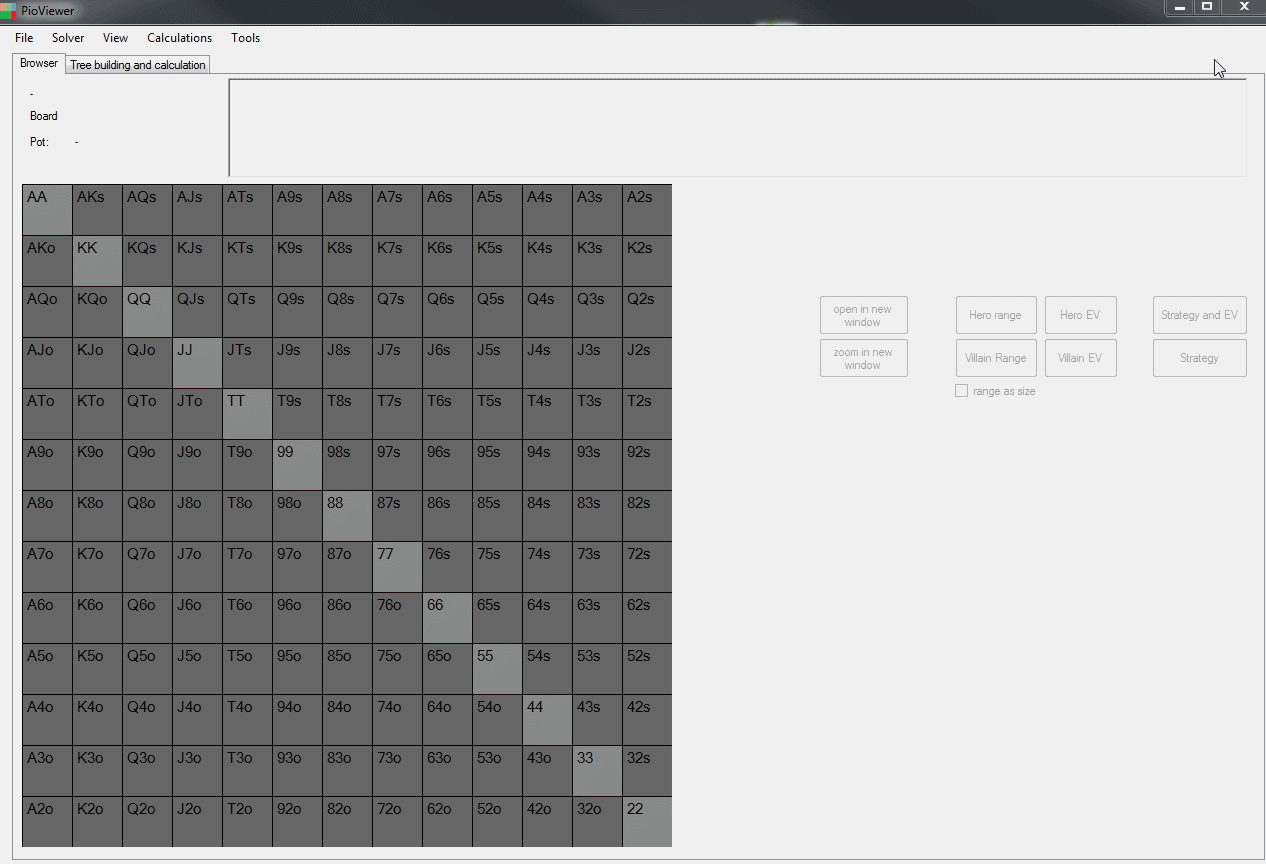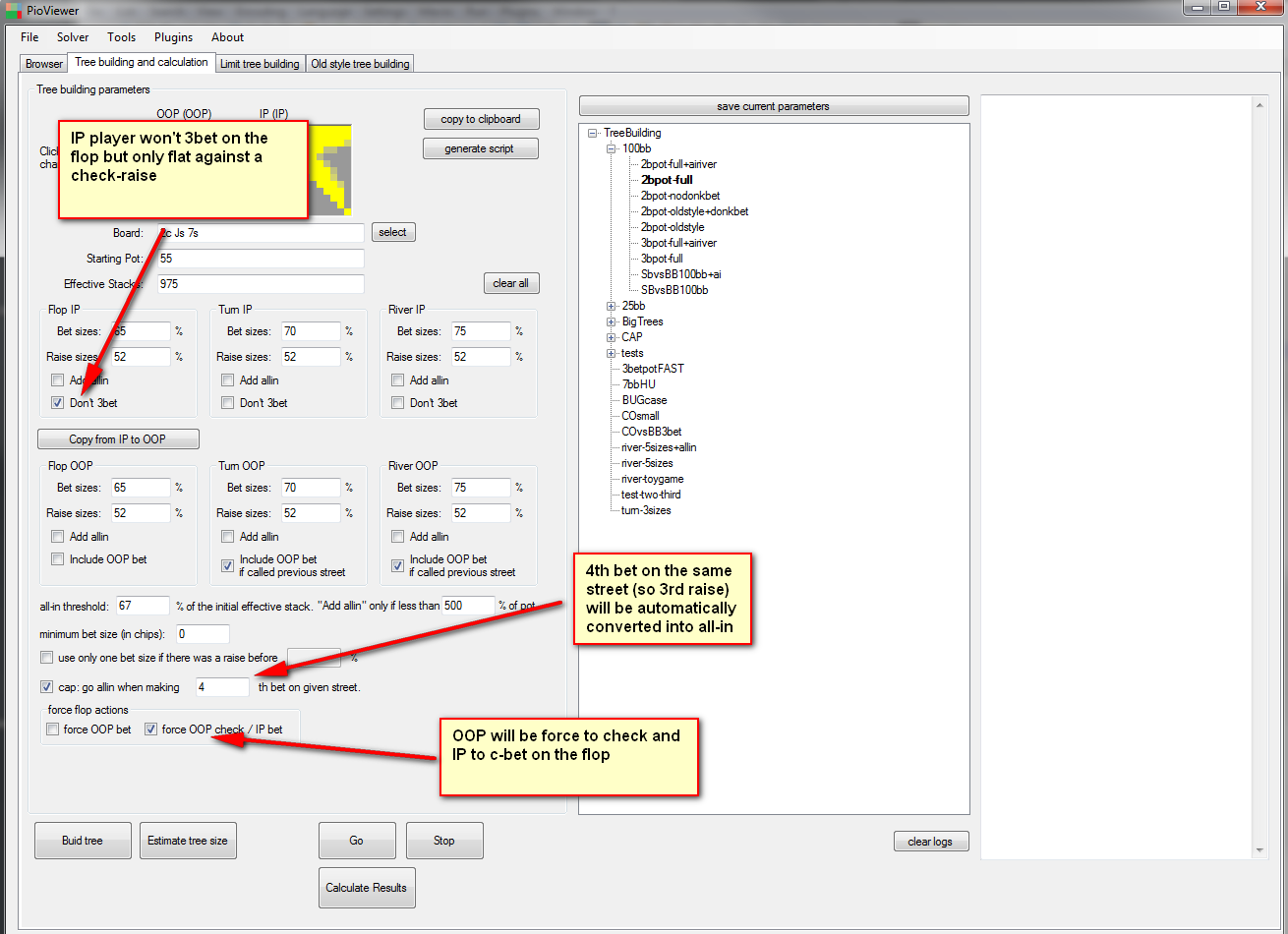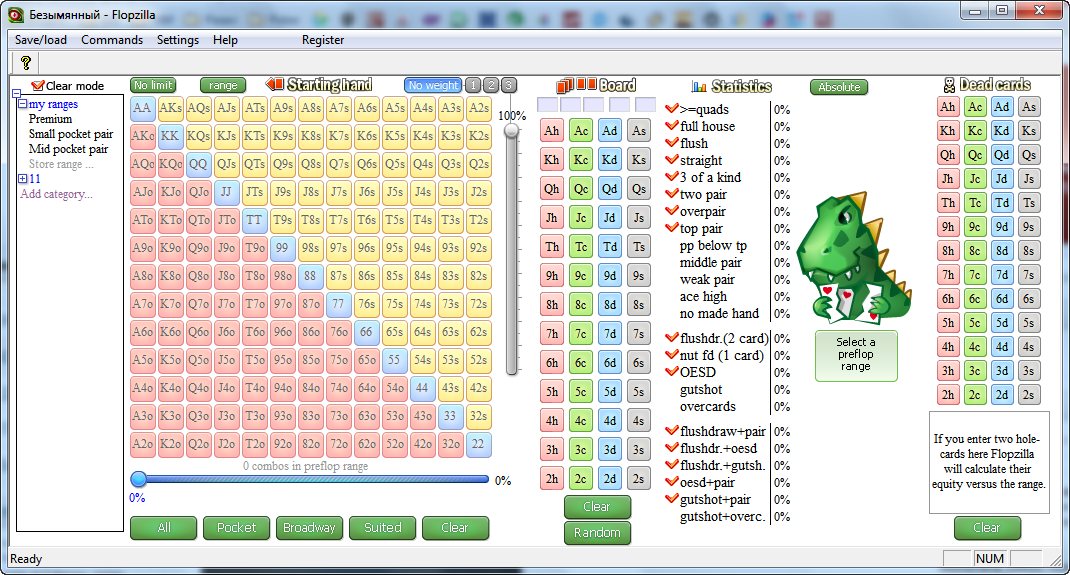
Piosolver is a relatively new piece of poker software that has been making waves in the poker community for some time now. With game theory approach to learning and playing poker growing more and more popular every day GTO learning tools become sought after and simply necessary for advanced hold'em players.
What is PioSolver?
Using some serious programming magic Piosolver is able to calculate extremely complex situations that just a few years back would be considered unsolvable by your standard home PC. PioSolver allows you to learn game theory optimal strategies in certain no-limit hold'em spots based on user input (arbitrary ranges, stack sizes, bet sizes). It's the ultimate tool for range vs. range analysis.
PioSolver can help you answer questions like:
- What should be the cbetting frequency on the flop when stealing in position against a standard blind defense range?
- What cbet sizing should you use in that spot?
- Which hands (if any) should you bluff raise on the turn in that situation if you're the one defending preflop?
- Is it optimal to lead with some hands on the flop if you're defending out of position?
- And much, much, much more.

Quick Start Guide
The first thing you need to do is to set up a "Tree" that you want to analyze. The Tree in Piosolver is basically a combination of two different ranges (in position and out of position) with various bet sizings, starting pot and stack sizes. You can setup player's ranges via an intuitive interface that resembles other pieces of poker software that allow for preflop hand selection (like PokerStove, Flopzilla or Equilab).
You can not only choose specific hands, but also limit the suits, combinations etc. You can also choose from a selection of predefined ranges and even save or import them from a file. Once you're satisfied with the ranges you need to input additional information like the board texture, starting pot size and effective stacks (assuming 5/10 blind structure). After that it's time to input bet and raise sizes on different streets for the in position and out of position player (if you want to allow for lead bets from out of position player make sure to tick the "Include OOP bet" box).
By inputting the "all-in threshold" you can make sure that if any of the previously set-up bet sizes would force one of the players to put x% of their effective stack into the pot they would just go all-in instead. You have a few other options, but this is basically everything you need to do to set up a functioning Piosolver Tree and start analyzing it.
Once you're ready you can click the "Estimate Tree Size" button to make sure you have enough RAM in your system to actually build it (which should be true for most modern PC's bought in the last five years or so as long you're not trying to analyze more than a few bet sizes at a time) and if that's the case you can build it and start calculating results (this process can take some time depending on how strong your PC is but given the sheer number of calculations your machine has to perform it's totally understandable).
Once you calculated the results it's time for the fun part! Analyzing the tree in the "browser" tab and learning about the proper game theory strategy based on the information that you provided. You can use the top panel in the browser tab to navigate from the 'Root' of your Tree through all the possible actions (betting or raising the amounts that you previously predefined, checking, calling, folding etc.) for both the in position and out of position player.
By using the buttons in the top right portion of the panel you can learn the exact EV and therefore the perfect strategy for every hand in your Tree. For example, if you input your standard CO vs BU ranges with around 2/3 pot betsizing on all streets, include some possible small overbets and 0.5x raise sizes you can learn that it's not optimal to ever lead out of position and instead you should only continue by calling. Knowing something like that is very very powerful and while learning about each and every scenario takes some time - and the quality of knowledge that you gain is dependant on your inputs - Piosolver is the ultimate key to solving your poker game.
With Great Power...
While the basic functionality is relatively easy to understand PioSolver is immensely powerful and it might take you a lot of time to figure out the right questions you should ask the software. The Piosolver community can be a huge help in that regard. In any case, you should be ready to put in some serious work into the process.
You'll have to learn how to approach the game from the GTO point of view in order to use Piosolver correctly. For example, many players find it unintuitive that even though you can set upIP and OOP ranges to analyze you can't tell the software which player was the one raising preflop. We're conditioned to think about preflop aggression as a factor when analyzing poker hands. We've all heard the words like 'initiative' or 'betting lead' hundreds if not thousands of times in coaching videos, strategy books, and poker forums.
In reality, preflop aggression isn't really a factor when you're trying to figure out what's truly optimal in a certain situation. It's not that using the word initiative when talking about poker was a stupid idea to begin with, it's totally fine to use arbitrary terms in order to make something that's super complicated (like poker) easy to understand. That being said you can't really use arbitrary, abstract terms to explain your thought process to poker software. In order to communicate with Piosolver, you'll have to start thinking in GTO terms which by itself might be worth the price of admission for some players.
Everyone who thinks that Piosolver will be a nail in the no limit hold'em coffin and that it will teach everyone who has enough money to pay for it a perfect GTO strategy is greatly misjudging the program. While it's true that Piosolver is immensely powerful and if used properly can make an already competent player into an absolute beast it's only as good as the questions you ask.

Should you use PioSolver?
If you're just starting out with poker and you're not participating in game theory classes at your school Piosolver will most likely be too complicated for you. That being said the initial barrier of entry is really low. Go and try the software for free to see if it can be beneficial to include it in your learning routine.
If you're an intermediate player and you're eager to better understand this beautiful and complicated game that is poker you should definitely consider using Piosolver... as long as it makes sense from the financial standpoint. While there's a free version available the fact that it can solve only turn and river situation is a pretty big deal if you're serious about using the software.
The basic version of Piosolver that adds the flop calculations to the mix will cost you 249$ which might be impossible to swallow by micro stakes players. That being said it's a one-time payment for a software that you'll probably use for the rest of your poker career (not unlike some other - though less pricey - programs like Poker Tracker or Flopzilla).
For advanced players out there it's a simple case of prisoner's dilemma. Long story short, whether it's good for poker's long term health or not other players will start using the Piosolver and if you want to stay on top of the game you have to follow suit.

Pricing
Piosolver is available in four different flavors with different feature sets. You can buy each version at a fixed price and you can upgrade to the higher tier at a later date if you decide to do so:
- PioSolver Free 0$
- PioSolver Basic 249$
- PioSolver Pro 475$
- PioSolver Edge 1099$
The free version of PioSolver is the slowest one, allowing for the limited use of your CPU threads (more on that later in the review). While the overall functionality of this version is surprisingly rich it has one major limitation - you can't calculate the flop scenarios, only turn and river ones. That being said I'd advise everyone (even if you have a thousand bucks burning a hole in your pocket right this second) to start with this option. Piosolver is a complicated program and it's a good idea to familiarize yourself with the interface before you make the purchase.
PioSolver Basic is faster, allowing you to use up to 4 CPU threads (which is coincidentally exactly the amount that most modern low to mid range processors has) and it doesn't restrict you to only turn and river situations. It's a perfect option for a low stakes player who still relies heavily on exploitative strategies to make money and who won't spend hours and hours on end with Piosolver but is ready to get his game to the next level. Keep in mind that even though the software is in constant development not every feature from Pro and Edge versions might make his way into the Basic one.

A Quick Word About Hardware
Since one of the perks of Piosolver's higher price tiers is unlocking the capability of using multiple processor threads it might be a good idea to talk a bit about hardware. An average poker player is usually not an expert when it comes to enthusiast PC parts and that's totally understandable.
If you're working on a mid-range business laptop with mobile CPU buying a Pro or Edge version won't make much sense for you. Those tiers are targeted at players using high end desktop parts intended for productivity. Here's a list of modern desktop processors that allow you to fully utilize high tiers of Piosolver:
- i7-3930K, i7-3960X, i7-3970X
- i7-4930K, i7-4960X
- i7-5820K, i7-5830K, i7-5860K
Verdict: 9/10
Piosolver is an impressive piece of software that allows users to learn more about the game of poker than it was ever possible with other tools. It also requires a lot of money, time and commitment from the customers if they want to tap into the full potential of this program.
 More Top Rated Content
More Top Rated Content
Articles
Coaching Videos

